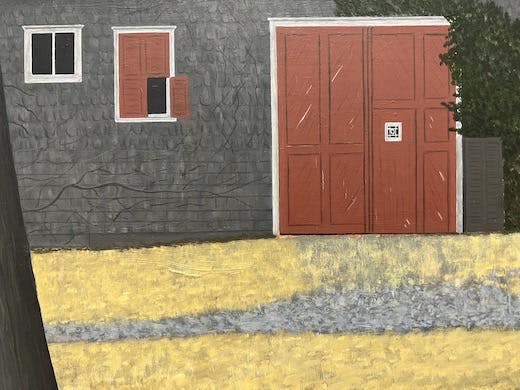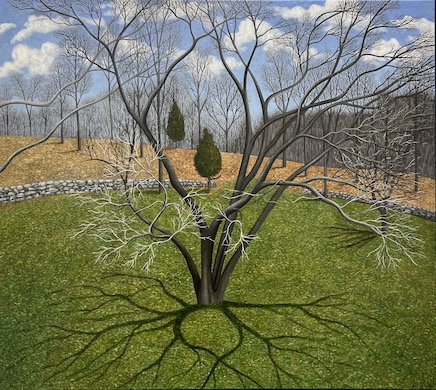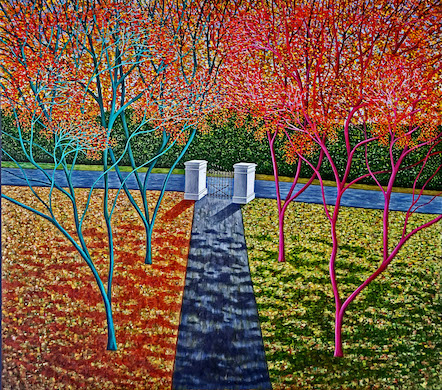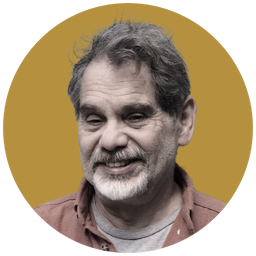Scott Kahn’s Intensely ‘Unique Voice’ Haunts Manhattan
Although there is a great variety of subject, his work changes little in its basic vibe or its look. It does not lose for this steadiness, always containing simmering drama.

Scott Kahn’s paintings are both haunting and hauntingly good. You can see his important vision at New York City’s Almine Rech Gallery through June 14.
They are haunting for a number of reasons, and, yes, they are odd — as from an original mind.
Mr. Kahn, who has lived, worked, and shown regularly in the New York orbit since the 1970s, says he strove to find his “own unique voice,” which he indeed has maintained, not overtly subject to the vicissitudes of self-doubt, for the past 40 years or so. Although there is a great variety of subject, his work changes little in its basic vibe or its look. It does not lose for this steadiness, always containing simmering drama.
Yet there is evolution, subtle like most aspects of his work, and it can be seen in these paintings ranging from 1982 to 2022. The later work is the more colorfully imaginative — or more consciously expressive — but the paintings had a distinctive intensity from the start. Some viewers may prefer the quieter ones, because the experience is so suppressed and drawn out.
Thus there is a flamboyant Scott Kahn and a restrained Scott Kahn, exemplified by “The Gate” (2022) and “Early Spring” (1992). The latter produces tension that stays in tension while it emanates from the painting. In the former, color energy detonates from the painting and is made all the more potent by the restrained tension that remains, even while the energy pushes outward. Provocatively, the content is imploding and exploding, but never really goes out widely beyond the painting itself — except that it drills directly into your mind.

In essence, the space is introverted: It doesn’t really push outside itself, it draws you in. The mood is introspective, often ominous, tantalizingly balanced by the concise painterly beauty.
An odd spatial structure contributes to this mood. The paintings’ space looks incomplete because it does not systematically include all the techniques of illusionism invented during the Renaissance. Mr. Kahn takes from that toolbox what he needs and mixes it with painting concepts he learned from starting his career as an abstract painter.
This explains a quality of Pissarro one can see in his treed landscapes, including “Early Spring.” In a Pissarro, the illusion of space is flattened in favor of attention to the arrangements of marks and shapes on the surface.
Mr. Kahn’s work also has a kinship with the early Renaissance, when illusionistic technique was not yet fully rationalized. The paintings of the 15th century Sienese master Sassetta are a good example of that, where the visual field feels both crowded together and pushed toward the front picture plane.
Traditions of American art are also brought to mind by Mr. Kahn’s work: The compressed (if not repressed) expressionist realism and personal space of Ammi Phillips, Edward Hicks, Grant Wood, John Steuart Curry, and Thomas Hart Benton, as well as the colored light of the Luminists like Martin Johnson Heade.

In contrast to all those traditions, the narrative in Mr. Kahn’s paintings is buried. For good reason: The content of your unconscious is at its most powerful when you don’t know what it is. He says, “The inspiration can come from something I see repeatedly in my daily life, or can be something I see in a flash.”
The sense of narrative is extruded from this and depends on feeling — not description — for meaning and impact. This comes from his obsessive attention to color, composition, and every resolute little brushstroke, which ultimately brings these paintings to life.
From the constancy of his style, it is clear that Mr. Kahn is not a follower of fashions. As chance would have it, there is a current trend in galleries for self-consciously quirky representational painting, so the genuineness of his work stands out in its full glory in contrast to artworks of posturing contrivance.
It has been thought that if an artist’s work looks strange at first, it is a sign that it is significant. But just setting out to make it strange won’t get you there. It has to be natural.
Mr. Kahn says he is “self-taught.” After attending art school and starting as an abstract painter, he is surely not naive. Allowing his unconscious free rein, he didn’t teach himself: His self taught him.
“I want a strong emotional response from a completed painting. That is my ultimate goal. The journey to get there is a matter of self discovery,” he says. Expressing the self through apposite skill explains the evocative individuality of his paintings.
There are demons in Mr. Kahn’s work. Everyone has demons. Painters certainly do — in fact, these may be the source of it all. Mr. Kahn’s demons are elicited by his insistence that truth come out. Exposing the demons can — as we know from both modern psychology and ancient tribal ritual — release them from your worried brow. The beauty of Scott Kahn’s work is in the high aesthetic and emotional pressure he creates to reveal and transform the demons.

